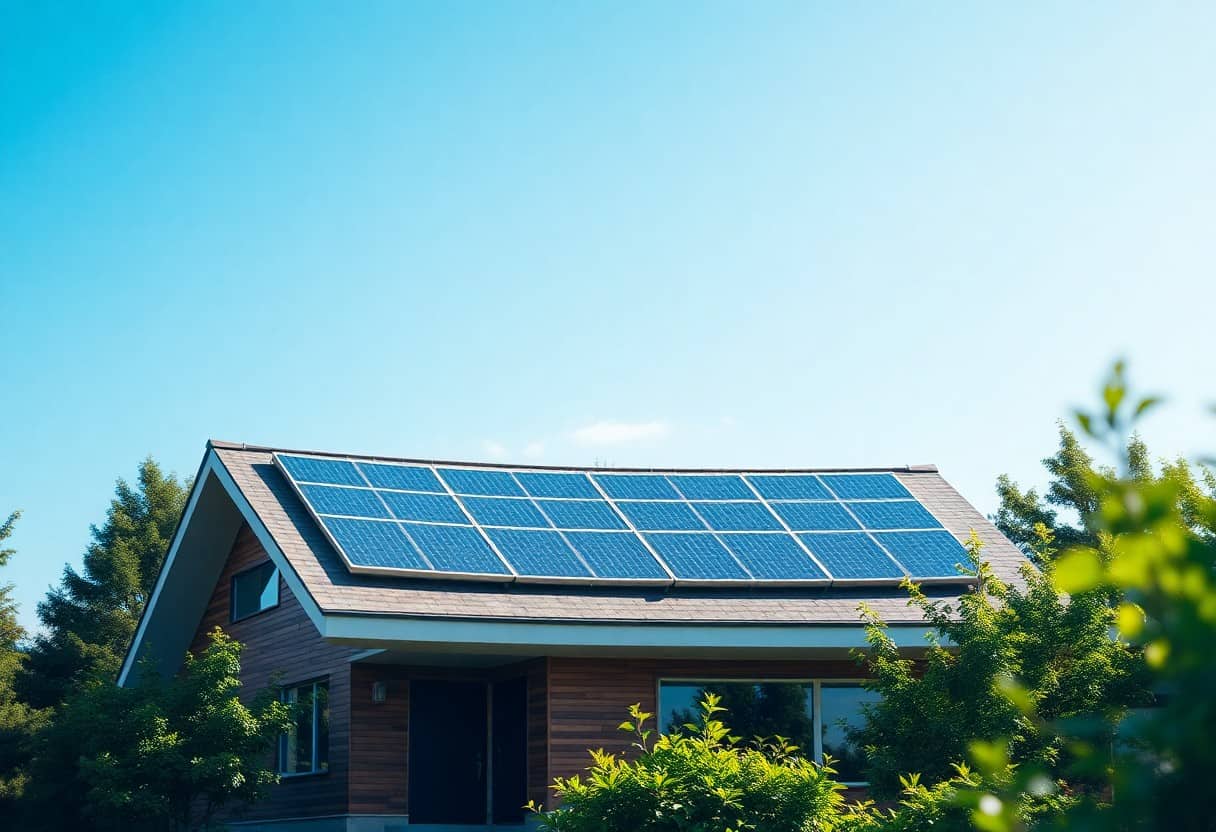Are there energy-efficient roofing options?
Fill Out The Form And We'll Get Back To You

There’s a growing awareness about the importance of energy efficiency in our homes, and your choice of roofing plays a significant role in this. Opting for energy-efficient roofing can help you reduce energy costs, improve comfort, and even enhance the overall value of your property. In this post, you’ll discover various roofing materials and technologies designed to maximise energy efficiency, making informed choices that suit your needs. Let’s explore the options available and how they can benefit you and your home.
Understanding Energy Efficiency in Roofing
To comprehend energy efficiency in roofing, it’s vital to explore how different materials and designs impact your home’s energy consumption. Energy-efficient roofing solutions are intended to minimize heat absorption while maximising insulation to regulate interior temperatures. By selecting suitable roofing options, you can enhance your home’s ability to maintain comfortable conditions, reduce reliance on heating and cooling systems, and ultimately lower your energy bills.
Importance of Energy-Efficient Roofing
Any investment in energy-efficient roofing not only bolsters your home’s sustainability but also contributes to significant savings on energy costs. By improving the thermal performance of your roof, you enhance indoor comfort and potentially increase your property’s value. The environmental benefits are substantial, as they can lead to a considerable reduction in carbon footprint.
Factors Affecting Energy Efficiency
Any number of elements can influence the energy efficiency of your roofing. These include the choice of materials, colour, insulation quality, ventilation, and overall roof design. It’s vital to consider how these factors interact to determine the effectiveness of your roofing system.
- Material type
- Colour and reflectivity
- Insulation properties
- Ventilation systems
- Overall roof design
Perceiving how each factor contributes to your roofing’s performance will enable you to make informed decisions when selecting energy-efficient roofing options.
At the core of energy efficiency lies the interaction of various elements, which must be carefully assessed to achieve optimal performance. The material you choose significantly affects how much heat your roof retains or reflects, while colour can either enhance or diminish this effect. Proper insulation and ventilation play vital roles in maintaining a consistent indoor temperature.
- Material choice
- Reflective colour
- Quality of insulation
- Ventilation methods
- Roof structure
Perceiving the interplay of these factors helps you maximise the energy efficiency of your roofing system.
Types of Energy-Efficient Roofing Materials
Any homeowner keen on energy efficiency should consider various roofing materials that can significantly reduce energy costs. Here are some popular options:
- Metal Roofing
- Slate Roofs
- Clay and Concrete Tiles
- Cool Roofing
- Reflective Shingles
Perceiving the right material for your home can greatly enhance energy efficiency and comfort.
| Material | Benefits |
|---|---|
| Metal Roofing | Durability and high reflectivity |
| Slate Roofs | Long-lasting and natural insulation |
| Clay and Concrete Tiles | Natural temperature regulation |
| Cool Roofing | Reduces heat absorption |
| Reflective Shingles | Minimises energy consumption |
Cool Roofing
To effectively combat heat absorption, cool roofing materials are designed to reflect more sunlight and absorb less heat. This helps maintain a stable indoor temperature, reducing the need for air conditioning and subsequently lowering your energy bills.
Reflective Shingles
Roofing materials like reflective shingles are crafted to deflect sunlight and decrease heat gain in your home. They are available in a range of styles and colours, ensuring aesthetic appeal without sacrificing energy efficiency.
Also, reflective shingles are often made from asphalt with a specially designed coating that enhances their reflectivity. This feature not only helps in maintaining cooler indoor environments but can also extend the lifespan of your roof by reducing thermal wear.
Green Roof Systems
Against conventional roofing options, green roof systems offer an eco-friendly alternative that promotes energy efficiency. These systems involve a layer of vegetation and soil, which insulates your home effectively and reduces urban heat island effects.
For instance, green roofs can improve air quality and support local biodiversity while providing excellent thermal performance. Additionally, they can help manage stormwater, lowering the risk of flooding and promoting sustainable water use in urban areas.
Benefits of Energy-Efficient Roofing
After investing in energy-efficient roofing, you will enjoy numerous benefits that enhance both your comfort and finances. These roofs can significantly reduce your energy bills by reflecting sunlight and reducing heat absorption, ensuring your home remains cooler in the summer and warmer in the winter. Additionally, energy-efficient roofing can extend the lifespan of your roof, leading to fewer replacements and repairs over time, while also increasing the value of your property.
Cost Savings
For homeowners, the cost savings associated with energy-efficient roofing can be substantial. By minimising energy consumption, you can expect lower heating and cooling costs throughout the year. Over time, these savings can offset the initial investment required for installation, making it a financially sound choice that benefits your budget in the long run.
Environmental Impact
Against the backdrop of increasing environmental concerns, adopting energy-efficient roofing can significantly reduce your home’s carbon footprint. This reduction is achieved through decreased energy consumption, which leads to lower greenhouse gas emissions and less strain on natural resources.
Due to the growing demand for sustainable living, energy-efficient roofing materials often come from recycled or sustainable resources, further minimising their environmental impact. By choosing these options, you not only contribute to energy conservation but also support industries that prioritise sustainable practices. This shift not only benefits your immediate community but also plays a part in the global effort to combat climate change.
Installation Considerations
Now, when considering energy-efficient roofing options, installation plays a significant role in the overall performance and longevity of your roof. Ensuring proper installation prevents issues such as leaks or decreased energy efficiency, so you should take your time to plan this phase. Whether you choose to hire professionals or commence on a DIY project, understanding the requirements will help you achieve the best results.
Professional Installation vs. DIY
Around many homeowners, the debate between professional installation and DIY is popular. While taking on roofing as a DIY project may seem cost-effective, it can also lead to potential pitfalls if you’re not well-versed in roofing techniques and safety protocols. Hiring professionals can provide you with peace of mind, ensuring that the job meets industry standards and integrates effectively with your existing structure.
Choosing the Right Material
Along with installation, selecting the right roofing material is vital for energy efficiency. The materials you choose will impact your roof’s insulation, reflectivity, and overall ability to conserve energy, thereby affecting your heating and cooling costs.
With numerous options available, you should consider factors such as thermal performance and durability when choosing your roofing materials. Metal roofs often boast excellent reflectivity, while slate and tile provide superior insulation. Additionally, consider the environmental impact of the materials and whether they are locally sourced, as this can further enhance your energy efficiency. Carefully weighing these elements will help you make an informed choice that aligns with your specific needs and goals.
Maintenance of Energy-Efficient Roofs
All energy-efficient roofs require regular maintenance to sustain their performance and longevity. Keeping your roof in optimal condition can enhance its energy-saving capabilities. You can find valuable insights on What is the Most Energy-Efficient Type of Roof? This includes conducting inspections and implementing cleaning techniques that ensure your roof reflects heat effectively and withstands environmental elements.
Regular Inspection
Behind every effective energy-efficient roof lies a commitment to regular inspections. As a homeowner, you should check for signs of wear and tear, leaks, or damage at least twice a year. Early detection can prevent costlier repairs down the line and prolong the life of your roof.
Cleaning Techniques
By maintaining cleanliness on your roof, you can significantly improve its energy efficiency. Regularly removing debris, such as leaves and moss, is key to preventing water accumulation, which can lead to damage and inefficiency.
And using a combination of gentle pressure washing and biocide solutions can help eliminate more stubborn algae or moss growths. Ensure that you avoid harsh chemicals that may damage roofing materials. Additionally, always prioritise safety when accessing your roof or consider hiring professionals for thorough cleaning sessions.
Comparison of Energy-Efficient Options
Your choice of energy-efficient roofing can be guided by the following comparison table that highlights key benefits and features of various materials:
| Metal Roofing | Durable, reflects heat, and sustainable. |
| Clay or Concrete Tiles | Excellent thermal resistance and longevity. |
| Cool Roofing | Reduces heat absorption and lowers cooling costs. |
| Green Roofs | Improves insulation and promotes biodiversity. |
Long-Term Performance
Before selecting a roofing option, consider its long-term performance, including how well it withstands weather extremes and its longevity. Energy-efficient materials often offer superior durability, ensuring that you maximise your investment by reducing the need for frequent replacements.
Return on Investment
Between upfront costs and long-term savings, evaluating your roof’s return on investment is imperative. Energy-efficient roofing can lead to decreased energy bills and increased property value over time, making it a financially sound choice.
LongTerm analysis of energy-efficient roofing illustrates that, despite initial expenditure, the cumulative savings on energy costs can significantly outweigh the initial investment. You can expect your roof to last longer and perform better, reducing maintenance needs and enhancing the overall sustainability of your home. Thus, investing in an energy-efficient option reflects positively on your finances and the environment alike.
Conclusion
From above, it’s clear that you have several energy-efficient roofing options at your disposal. Choosing materials like metal, slate, or tile, or incorporating reflective coatings can significantly reduce heat absorption, helping to maintain a comfortable temperature in your home. Additionally, these options can contribute to lower energy bills and a reduced carbon footprint. By considering energy-efficient roofing, you’re investing in a sustainable future for both your living space and the environment.
FAQ
Q: What are energy-efficient roofing options available?
A: There are several energy-efficient roofing options that homeowners can consider. Popular choices include reflective roof coatings, which can reflect sunlight and reduce heat absorption, as well as metal roofing, which often has high solar reflectance. Additionally, green roofs, which are covered with vegetation, provide insulation and reduce heat transfer. Asphalt shingles designed for energy efficiency and clay or concrete tiles also offer considerable thermal performance.
Q: How do energy-efficient roofs benefit homeowners?
A: Energy-efficient roofs can significantly lower energy bills by reducing the amount of heat that enters a home, thus decreasing the need for air conditioning during warmer months. They can also improve indoor comfort, reduce the heat island effect in urban areas, and contribute to the overall sustainability of a property. Furthermore, some energy-efficient roofing materials may be eligible for tax credits or rebates, providing financial benefits over time.
Q: Are energy-efficient roofing options more expensive than traditional roofing materials?
A: While some energy-efficient roofing options may have a higher upfront cost compared to traditional materials, they often provide long-term savings through reduced energy bills and maintenance costs. Additionally, the enhanced durability of many energy-efficient materials can lead to fewer replacements over time, making them a cost-effective choice in the long run. It is advisable to evaluate the total cost of ownership rather than just the initial investment.
Re-Roof of Bungalow
The team made a fantastic job of replacing the roof on our bunglaow. They were fasy, reliable and excellent value for money.
Chimney Removal
We employed Wrights Roofs to take down our very old chimney – tht had seen better days. They carefully removed and made good the area where the chimney was. Really impressed.
New Roof
We had an extension built and Wrights came and put a new roof on. They were brilliant, no fuss, great value for money. Thank you.
Roofs, Flat Roofs Chimneys and Solar Panels
If you need roof work on your home, please complete the form or call us today.

